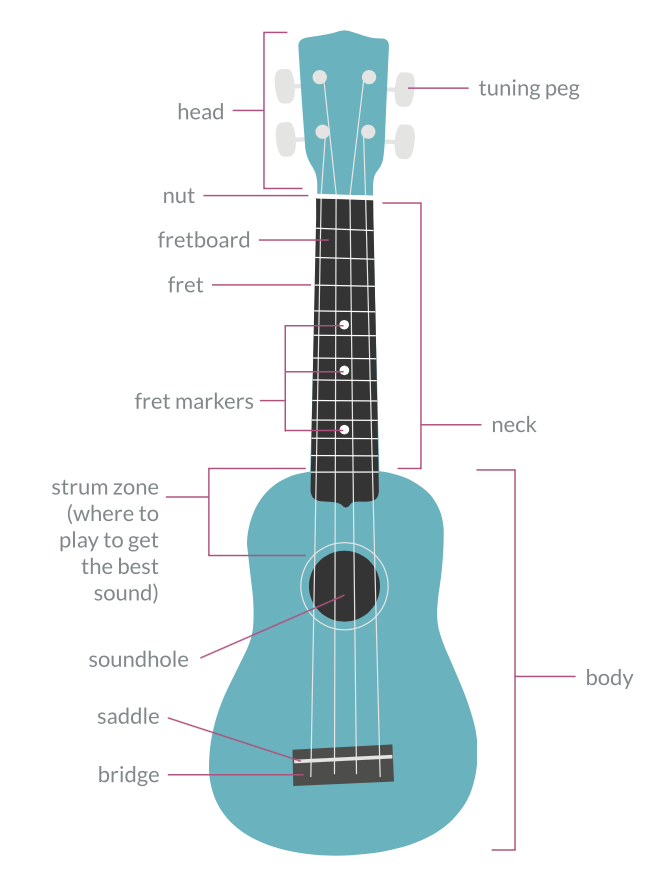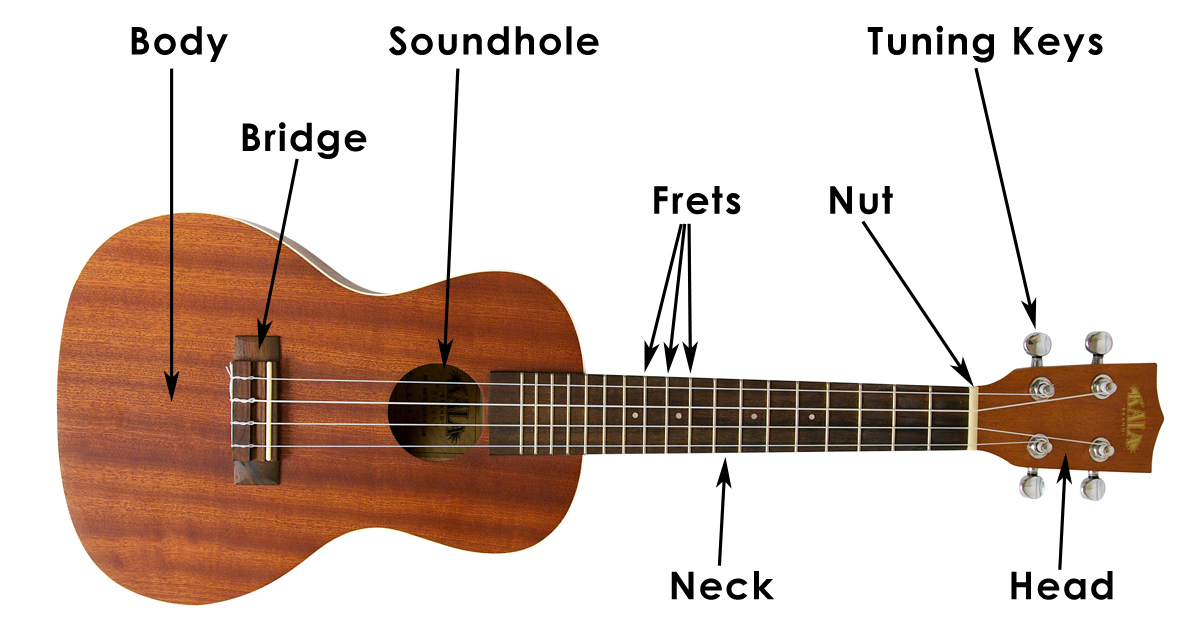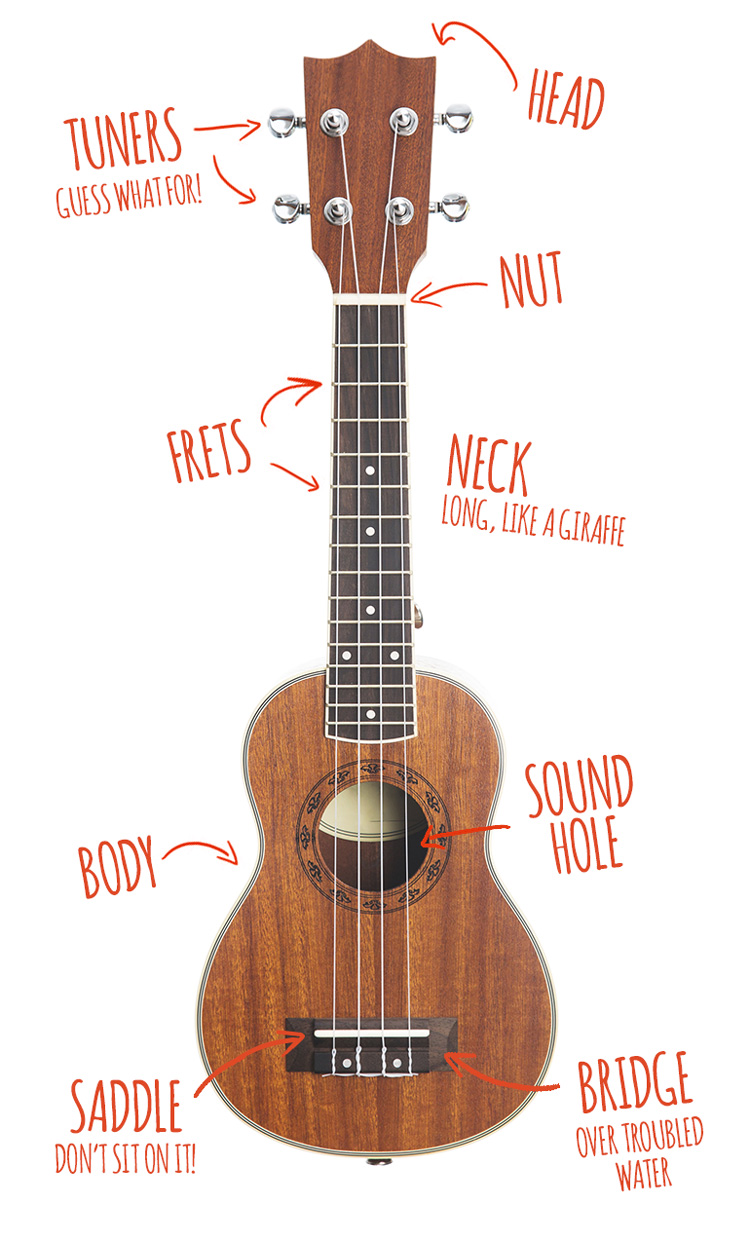Understanding your ukulele involves knowing its parts, tuning, and care practices. Mastery comes with recognizing chords, strumming patterns, and playing techniques.
A ukulele is not just a miniature guitar; it’s an instrument with a charm and a personality all of its own. Whether you’re a strummer at the beach or an aspiring virtuoso, the ukulele offers a gateway to musical expression that is both accessible and nuanced.
The journey of ukulele proficiency begins with the basics – from the distinct sounds of its four nylon strings to the different sizes available, such as soprano, concert, tenor, and baritone. Each size factors into the tone and playability, making your choice a personal statement. Tuning your ukulele to the common G-C-E-A or exploring alternative tunings brings out its versatile nature. Understanding the subtle differences in wood types and construction will impact the resonance and quality of sound. Beginners and seasoned players alike must continually hone their skills, building a repertoire of chords and developing a feel for rhythm. Above all, knowing your instrument means engaging with the community of ukulele players and appreciating the rich cultural history that accompanies this beloved instrument.
The Birth Of The Ukulele
Imagine a small instrument creating big waves in the music world. That’s the story of the ukulele, a four-string wonder. It has charmed people for over a century, connecting cultures and spawning countless melodies. Let’s uncover how the ukulele came into existence. Where did it start? How did it reach the sunny shores of Hawaii? Prepare to be enthralled by the fascinating origin of this beloved instrument.
Portuguese Origins
The ukulele has its roots deep in the heart of Portugal. In the 19th century, Portuguese immigrants sailed to Hawaii. They brought an instrument named the ‘machete.’ This small, guitar-like instrument had four strings. Craftsmen in Portugal had refined the art of making such instruments for generations.
Made of native woods like koa or acacia, these instruments were both durable and beautiful. Locals in Portugal loved them for their bright and cheerful sound. Imagine the scene as Portuguese laborers shared their music. It brought a piece of their homeland to Hawaii. Their music delighted everyone who heard it.
Hawaiian Adoption And Evolution
Hawaii welcomed the machete with open arms. But the Hawaiian people did not just adopt it; they made it their own. They renamed it ‘ukulele,’ which means ‘jumping flea.’ Legends say it was named for the lively movement of the player’s fingers.
Over time, the ukulele took on new shapes and sizes. Different types of ukuleles emerged, such as soprano, concert, tenor, and baritone. Each offered a unique sound and feel. Hawaiian craftsmen began using koa wood from their own forests. This added a rich, local flavor to the instrument’s sound.
The ‘uke’ became a symbol of Hawaiian culture and spirit. It went from a humble immigrant instrument to a global sensation. Today, it’s impossible to imagine a luau or hula without the sweet strumming of the ukulele.

Credit: www.musicalmama.com
Anatomy Of The Instrument
Taking a deeper look into the anatomy of your ukulele can reveal the secrets behind its charming sound. Whether you’re a seasoned player or a newcomer, understanding these details will enhance your playing experience. Let’s unwrap the layers of this compact instrument.
Different Sizes And Their Tones
Ukuleles come in various sizes, each crafting its own unique tone. The sound and playability change with each scale, offering a range to suit different music styles and player preferences.
- Soprano Ukulele: Delivers a classic, bright ukulele sound.
- Concert Ukulele: Slightly larger, with a richer tone.
- Tenor Ukulele: Offers a deeper tone, preferred for fingerpicking.
- Baritone Ukulele: Closest to a guitar’s sound, with a warm resonance.
Essential Parts: From Tuning Pegs To Sound Hole
The ukulele’s magic comes from its carefully crafted parts. Each part plays a crucial role in creating that sweet ukulele melody.
| Part | Function |
|---|---|
| Headstock | Houses the tuning pegs; balances the instrument. |
| Tuning Pegs | Adjust the tension of strings; tune the instrument. |
| Nut | Supports strings at the headstock; keeps proper spacing. |
| Neck | Supports the fretboard; player’s hand slides along it. |
| Fretboard | Has frets that divide pitches; where fingers press down. |
| Sound Hole | Projects the sound; vibrates with the strings. |
| Body | The large cavity that resonates to amplify sound. |
| Strings | Vibrate to produce sound; different materials affect tone. |
| Bridge | Secures strings to the body; transfers vibrations. |
| Saddle | Raises strings above the fretboard; affects action and sound. |
Types And Tones
The ukulele, often associated with the gentle waves of Hawaii, comes in various sizes. Each size offers a distinct sound that influences your music. Let’s dive into the different types and their unique tones.
Soprano
The soprano ukulele is the smallest of the family. It’s known for its traditional, bright tone. Its compact size makes it perfect for travelers or young musicians. Soprano brings the classic ‘ukulele sound’ to life:
- Pitch range: High
- Size: 20-21 inches
- Typical tuning: G-C-E-A
Concert
The concert ukulele offers a fuller sound and more playing space than the soprano. It suits those who find a soprano too compact. Its tone is rich and its volume louder:
- Pitch range: Warm
- Size: 23 inches
- Typical tuning: G-C-E-A
Tenor
Tenor ukuleles provide a deeper tone and more volume. Artists favor this type for its range and fuller sound. It’s versatile and suits various music styles:
- Pitch range: Deep
- Size: 26 inches
- Typical tuning: G-C-E-A or D-G-B-E
Baritone
The baritone is the largest and boasts a tone closest to a classical guitar. It is ideal for players looking for a robust, rich sound:
- Pitch range: Very deep
- Size: 30 inches
- Typical tuning: D-G-B-E
Wood Varieties And Sound Quality
The wood used to craft a ukulele significantly affects its sound. Different woods produce unique tones:
| Wood Type | Tone Quality |
|---|---|
| Mahogany | Warm, soft |
| Koa | Bright, rich |
| Spruce | Crisp, loud |
| Cedar | Sweet, mellow |
| Maple | Balanced, focused |
Different woods not only provide unique aesthetics but also influence the resonance and sustain of a ukulele’s voice. Choose wisely to find your perfect sound.

Credit: www.learntoplaymusic.com
Mastering The Strings
Unlock the sweet melodies of your ukulele by mastering its strings. Like a painter’s brush on canvas, each string on your ukulele is a channel for creativity. To make beautiful music, understand the strings and how to control them. This section dives deep into standard tuning’s role and explores the art of strumming and plucking.
Standard Tuning And Its Importance
Every ukulele player must grasp standard tuning. It is the foundation of your musical journey. Standard tuning aligns the ukulele to a familiar sound, making it possible to play with others and use learning resources. The strings are usually tuned to G C E A. This order, from top to bottom, is your key to consistency and harmony.
| String Number | Note |
|---|---|
| 1 (top) | G |
| 2 | C |
| 3 | E |
| 4 (bottom) | A |
Techniques: Strumming And Plucking
Strumming and plucking are the heartbeats of ukulele music. They bring songs to life. Strumming creates rhythm, while plucking highlights melody. Both techniques vary in complexity from simple to elaborate patterns.
- For strumming, you use your fingers or a pick to brush over the strings. This creates a fuller sound. Develop a steady rhythm. Pacing is crucial.
- With plucking, you play each string individually. This requires precision. It spotlights specific notes and tunes.
- Start with basic down-strums.
- Progress to alternating up and down strums.
- Experiment with finger positioning for different effects.
- Explore melody lines through plucking individual strings.
Consistent practice aligns strumming and plucking with your musical voice. Begin with simple songs. Stretch your skills as you grow. Delve into different genres. Your ukulele awaits your command.
Cultural Impact And Famous Players
The ukulele has strummed its way into the hearts of people worldwide. Its cheerful sound is a beloved staple in many cultures. Legends have picked it up, and its melody has echoed across generations. From moonlit beaches to bustling city streets, the ukulele’s charm resonates.
Ukulele In Mainstream Music
The ukulele has seen a major resurgence in popularity. It graces the tracks of various artists across genres. It brings a touch of joy to countless fans. Its unique sounds have found a place in pop, rock, and indie music. The instrument’s versatility is undeniable.
- Weights in beats and calm in melodies, the ukulele is a staple in today’s hits.
- Singer-songwriters often turn to its four strings for inspiration.
- Mainstream music includes the ukulele for its distinctive and approachable vibe.
Influential Ukulele Musicians Through The Decades
Throughout history, some musicians have stood out for their mastery of the ukulele. They have inspired generations to pick up the instrument.
| Decade | Musician | Impact |
|---|---|---|
| 1920s | Roy Smeck | Wizard of the strings, a true virtuoso. |
| 1960s | Herb Ohta | Instrumental magic, the sound of waves. |
| 2000s | Jake Shimabukuro | Melodic innovation, mesmerizing technique. |
Each artist mentioned has contributed uniquely to the ukulele’s legacy. Their visions and styles have helped shape the instrument into what it is today. Music lovers treasure their performances and recordings.

Credit: ukulelego.com
Maintaining Your Ukulele
Maintaining your ukulele is the key to its longevity and ensuring its beautiful sound for years to come. Like any cherished instrument, the ukulele requires regular care. Learn the best ways to keep your ukulele in top condition with these simple but crucial tips.
Regular Cleaning
Keeping your ukulele clean is crucial. Dust, dirt, and oils from your skin can damage the wood and strings over time. Follow these steps to keep your ukulele looking and sounding its best:
- Wipe down your ukulele with a soft, dry cloth after each use.
- Use a slightly damp cloth for stubborn grime, but make sure to dry it immediately.
- Clean the fretboard with a specialized cleaner every few months.
- Polish the body occasionally to maintain its shine and protect the wood.
Proper Storage And Handling
Storing your ukulele properly preserves its condition and prevents unnecessary wear. Follow these guidelines to safeguard your instrument:
- Keep your ukulele in a case or gig bag when not in use.
- Maintain a stable environment; avoid extreme temperatures and humidity.
- Hang your ukulele on a wall hanger or place it on a stand when you’re not playing it.
- Never leave it on the floor where it could get stepped on or damaged.
When To Change The Strings
Strings affect the sound and playability of your ukulele. They should be changed regularly. Look out for these signs to know it’s time for new strings:
| Sign | Action Required |
|---|---|
| Dull or flat sound | Change strings |
| Visible wear or discoloration | Change strings |
| Strings become hard to tune | Change strings |
| Cracks or fraying | Change strings |
Choosing the right time to change your strings ensures your ukulele always sounds its best. Consider changing your strings every three to six months, or more often if you play frequently.
How Can Understanding Your Ukulele Improve Your Performance of “Do It for Her”?
Understanding your ukulele can significantly enhance your performance of “Do It for Her.” By mastering its chords and techniques, you align your emotions with the music, creating a heartfelt rendition. This connection becomes a source of ukulele inspiration for her musical journey, elevating both your skills and her experience.
Frequently Asked Questions On How Well Do You Know Your Ukulele
What Are The 4 Basic Ukulele Chords?
The four basic ukulele chords are C major, G major, A minor, and F major. These foundational shapes are essential for beginners to learn first.
How Do I Choose A Ukulele For Beginners?
Select a soprano or concert ukulele for a comfortable start. Opt for a ukulele made from quality wood like koa or mahogany. Look for geared tuners for reliable tuning. Check for smooth frets and a comfortable neck. Read reviews and test different ukuleles for the best feel.
What Is The First Note To Learn On The Ukulele?
The first note to learn on the ukulele is usually the C note. It’s played on the third fret of the bottom A-string. This note is fundamental for beginners due to its simplicity.
How Hard Is It To Learn Ukulele?
Learning to play the ukulele is relatively easy due to its small size, few strings, and simple chord structures. Beginners can quickly master basic chords and play songs, making it an accessible instrument for all ages.
Conclusion
Exploring your ukulele’s quirks and features unlocks endless musical journeys. Like any instrument, mastery is a continuous adventure, full of discovery. Keep strumming, learning, and expanding your repertoire. Your ukulele is more than a hobby—it’s a portal to artistic expression.
Cherish each chord and melody as you grow in harmony with your beloved ukulele.
